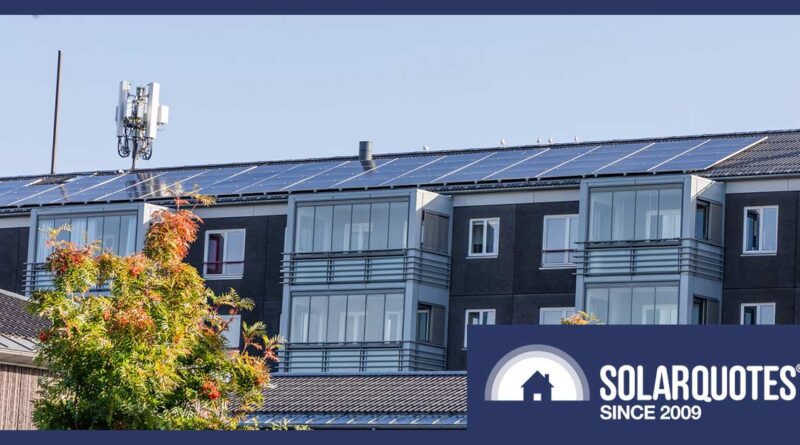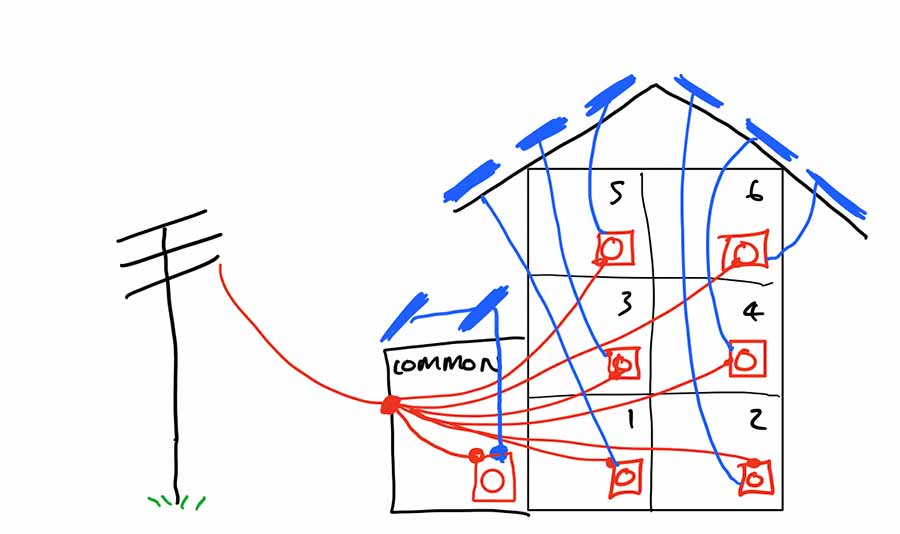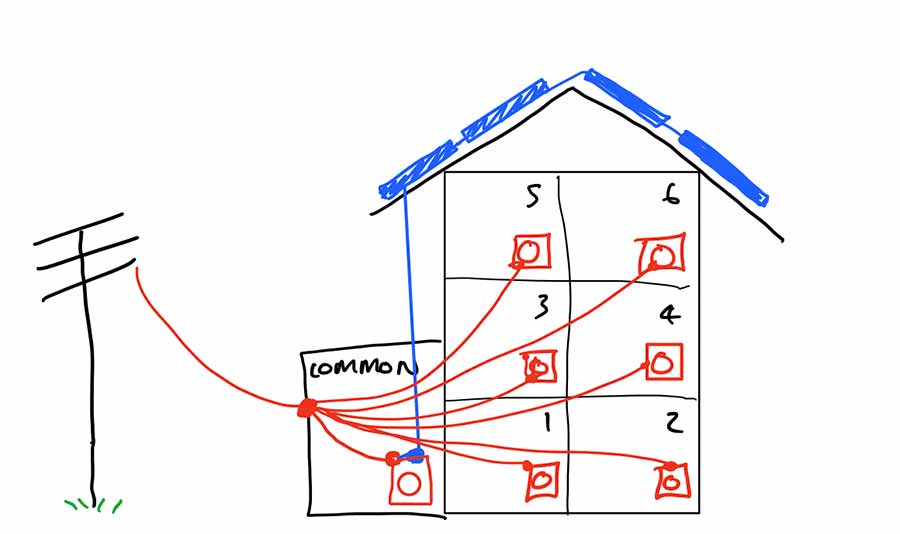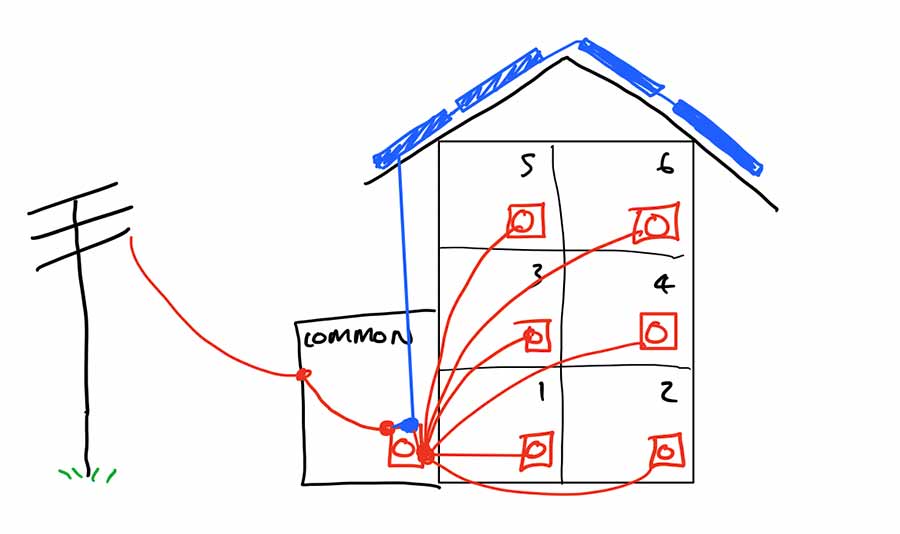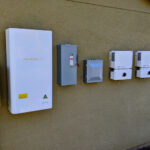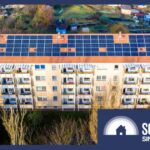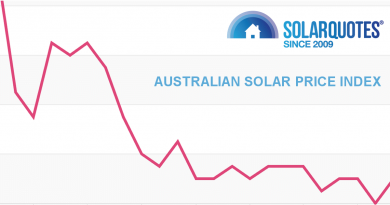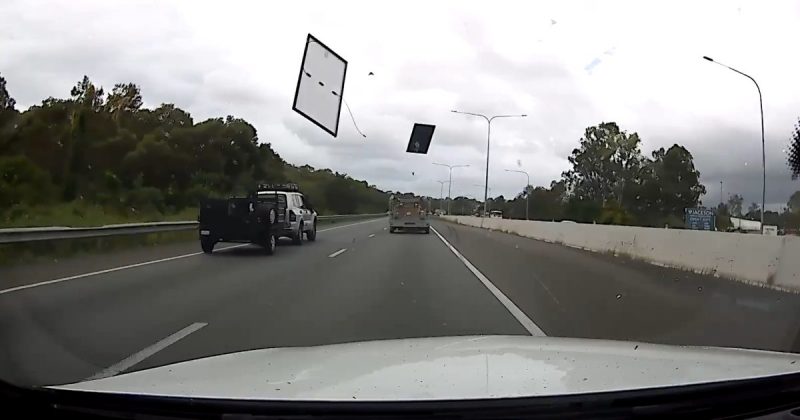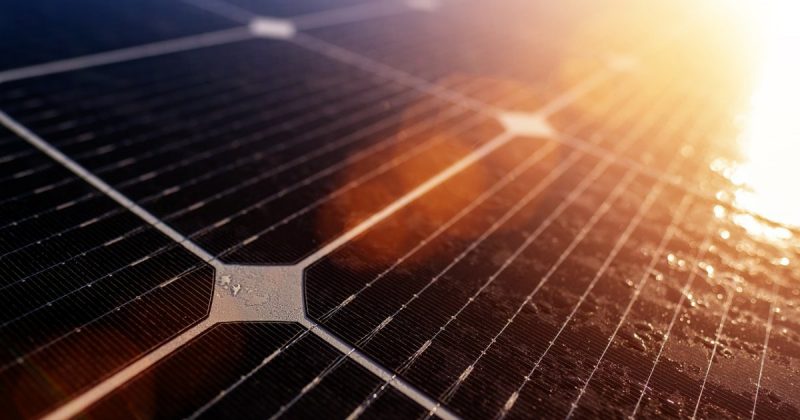Allume SolShare Makes It Easier For Stratas To Go Solar
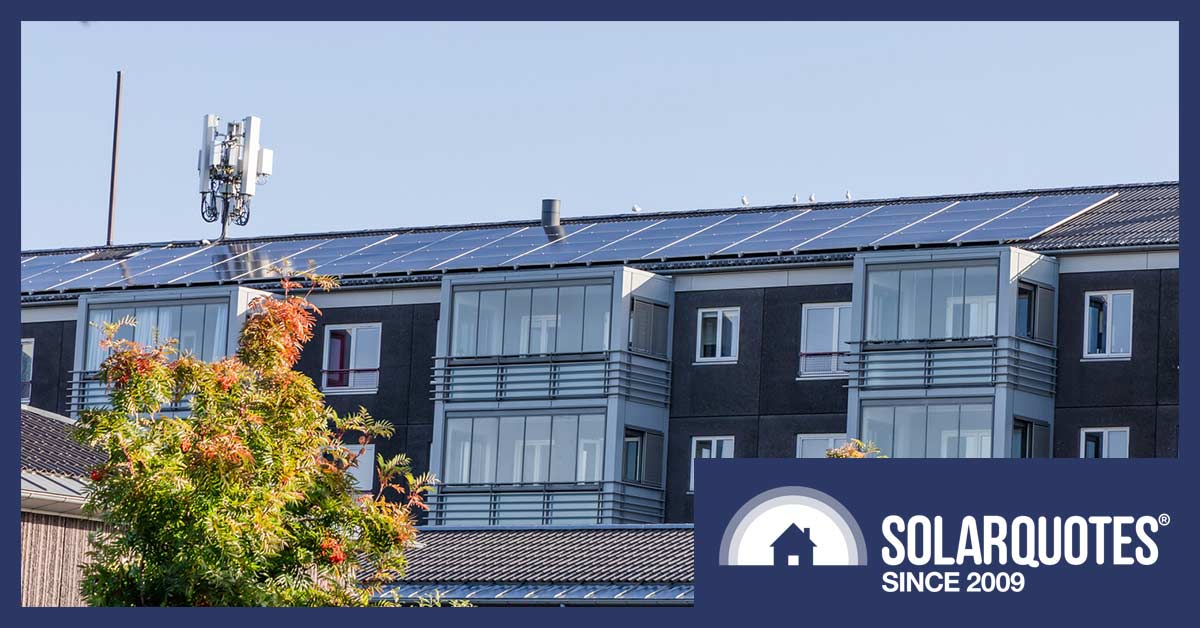
Putting solar panels on a Strata property is often tricky. There can be technical challenges with the design and installation, not to mention the political challenges of dealing with multiple owners and a shared roof.
Making solar power easy for people in multiple occupancy buildings is a tough nut to crack. Some good news is Allume Energy appears to have developed a powerful nutcracker in its SolShare system that distributes energy from one large solar system to multiple users in a building.
One SolShare — which is a box full of electronics plus software — can supply solar energy to a maximum of 15 different metered consumers in a Strata title property. The largest number of connections so far is in Eveleigh, NSW, where six SolShares are supplying a block of 88 apartments.
A major benefit of Solshare is it will always try to send solar energy to its users instead of into the grid for a feed-in tariff. Because a dozen apartments have a much steadier average daytime electricity consumption than a single household, this results in more solar self-consumption and lower electricity bills.
The SolShare is designed nd manufactured in Australia by Allume Energy. There are around 150 SolShares installed in Australia and more overseas. They are exported to the UK, USA, EU, and — for all I know — other letters as well.
In this article, I’ll outline what a SolShare is, how it works, and how you get one.
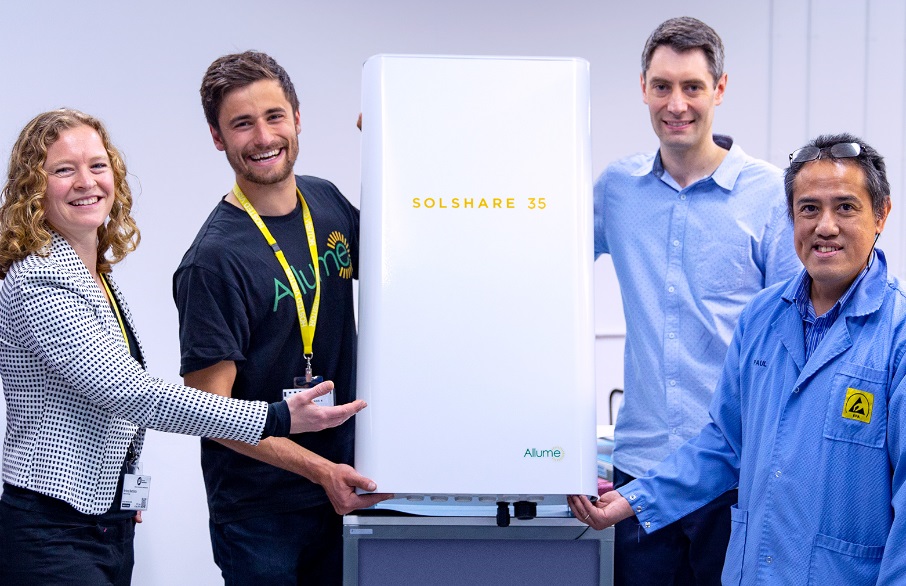
This is what the SolShare looks like. Or rather, what its skin looks like since this is just the cover. Unless they’re all secretly buff under their shirts, there’s no way they could hold a 38 kg unit like that. So I guess that makes this group a SolShare cover band.
A Two-Minute Explanation
About a year ago, Allume Energy gave SolarQuotes a two-minute rundown of SolShare. If you’d rather watch that than read, you can check it out below. Of course, you’re welcome to watch it in addition to reading my wonderful prose:
Strata Properties Only
SolShare is only for Strata properties. In case you are wondering what Strata is — perhaps you’re one of the lucky people who’ve never had to deal with it — it’s a property title that allows individual ownership of part of a property while sharing ownership of common areas and the land.
If you want to make any significant changes to shared areas, such as installing solar panels on the roof, you generally need to get a majority — or sometimes all — of the owners’ corporation to go along with it. This can make getting solar in these situations very difficult. Fortunately, it’s getting easier thanks to solar power becoming mainstream and more people appreciating its benefits.
All Electricity Meters On 1 Switchboard
If a property has multiple electricity meters on one switchboard, then it’s likely to be suitable for SolShare. If a Strata property has separately located meters, it will complicate the installation and increase costs because there will be many long cable runs.
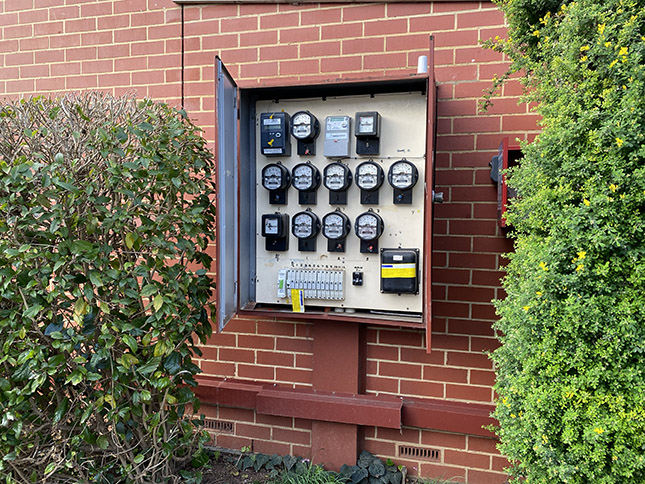
Current Methods Have Drawbacks
Before Solshare were three main options for shared solar on a Strata property:
-
- Each member of the Strata that want solar power gets their own, often small, individual solar system on the roof. And perhaps one for the common areas too.

- One large solar system supplies energy to the common areas.

- One meter for the solar system, and sub-meter everyone else.

- Each member of the Strata that want solar power gets their own, often small, individual solar system on the roof. And perhaps one for the common areas too.
With the first approach, installing multiple small systems with their own inverters and cables is more expensive than installing one large system of the same total capacity. Individual solar systems can also only supply power to their own dwelling or business and are unable to share it with other members of the Strata.
With the second approach, the cost per kilowatt of solar capacity can be less, but it only reduces grid energy consumption in the common areas. As this often isn’t high — especially during the day — it can result in most solar energy being fed into the grid for a feed-in tariff providing a much lower return than directly using it to offset grid consumption.
The third approach will maximise solar savings, but is the most difficult technically and politically. It usually needs to be done for every resident, requires new sub-meters for everyone and, worst of all, someone needs to set themselves up as an electricity retailer to do the billing.
Many companies will do this for you and become your electricity retailer. It’s called an ’embedded network’. But the embedded network operator will need to charge enough per kilowatt-hour to pay their costs and turn a profit – reducing the savings for the residents.
SolShare gives the maximum solar savings of the third option, but each resident can keep their own grid-meter and electricity retailer. Residents can also opt-out of solar power entirely, making the strata politics much easier.
SolShare Shares Solar
SolShare lives up to its name because it shares solar power. While that may not sound so special, as most of us learned how to share back in pre-school, it required Allume Energy to develop a new type of technology called a Power Diversion Control System.
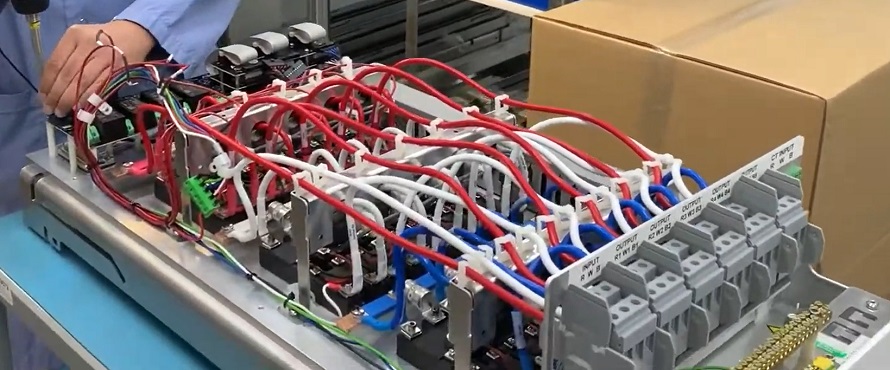
This is the SolShare after it has been peeled. As you can see, it contains a lot of wires. (Note you’ll have to cough up for the SolShare. Using a box full of wires will not result in a satisfactory outcome.)
This will preferentially send solar energy to any of the connected users in the Strata before exporting the surplus to the grid. This results in higher solar self-consumption than if individuals had their own solar systems that added up to the same total capacity. The SolShare site uses the following graphs to show the difference:
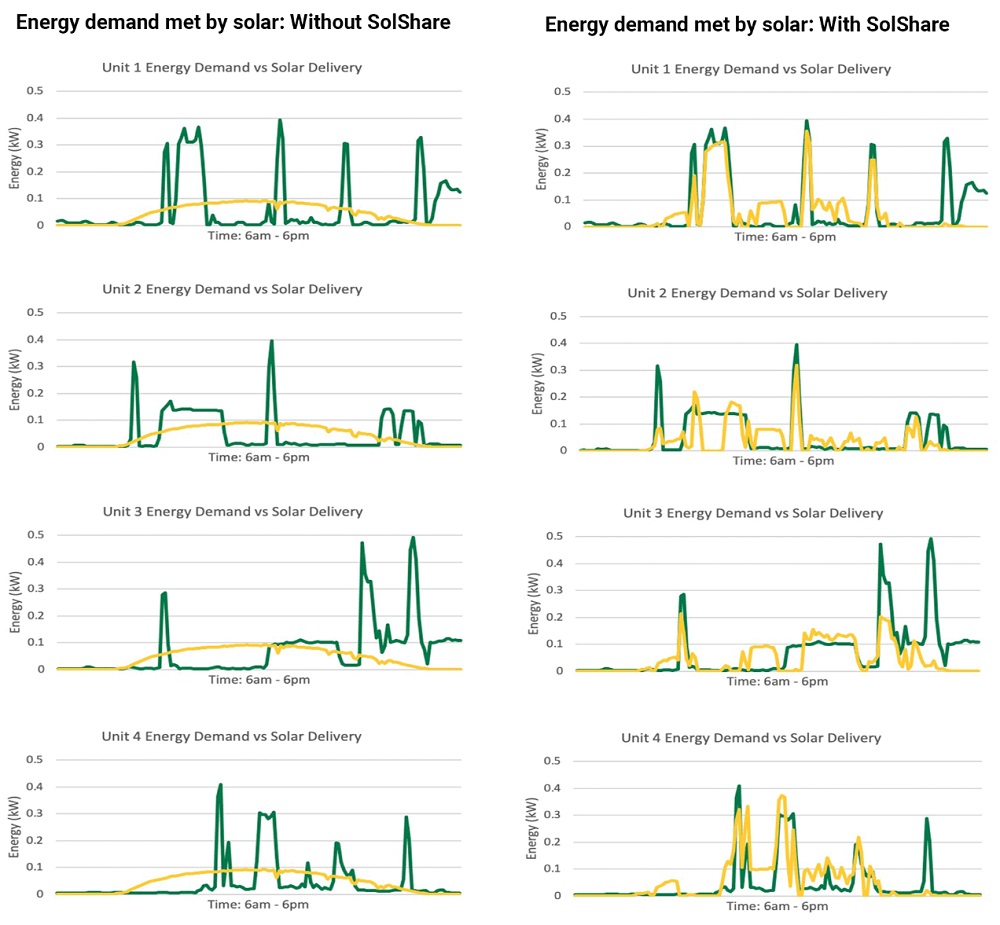
In practice, there would normally be more than four separate users connected to one SolShare.
The four graphs on the left show how much electricity consumption is met by solar for four units with small individual solar systems. The graphs on the right show how much consumption is met using SolShare. While you can’t expect solar self-consumption always to be as good as the graphs on the right suggest, Allume Energy claims SolShare will increase self-consumption by 40-50%.
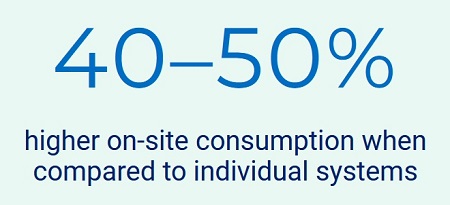
See? They claim it right here!
Assuming this claim is correct, a home that would have 40% self-consumption with its own individual system would have 56-60% self-consumption with SolShare and proportionally identical solar capacity.
This improved solar self-consumption will decrease the already relatively short time it normally takes solar to pay for itself. The reduction will vary by location and electricity plan, but can easily reduce the payback time by over 25%.
Avoiding Export Limits
While a large block of flats can draw a hefty amount of power from the grid, it’s not uncommon for them to be far more restricted in how much solar power they can export to the grid. By maximizing self-consumption SolShare reduces exports and potential losses from export limits. Even in an extreme situation with a zero export limit, the owners of a Strata property may still find a SolShare system worthwhile.
Up To 15 Connections Per SolShare
The majority of Strata homes and businesses have single-phase power. If it’s a large building, power to common areas is often 3-phase but may be single-phase. There are also Strata properties that don’t have power to common areas.
One SolShare can provide 3-phase power to a maximum of five metered consumers on a Strata property. Alternatively, each 3-phase connection can supply up to three single-phase connections. This allows a maximum of 15 single-phase connections.
It’s no problem for one SolShare can have both 3-phase and single-phase connections. For example, a SolShare could supply:
-
-
- 3-phase power to the common areas.
- 3-phase power to a business on the ground floor.
- Single-phase power to nine flats on the floors above.
-
If more connections are required, multiple SolShares can be used. Another option is to use extra SolShares to increase each user’s portion of solar panel capacity to allow them to receive more solar energy.
5-60 SolShare Connections Usual
Allume says up to around 60 connections is the usual limit. But, provided the conditions are right, they can go higher. As mentioned earlier, they have used six SolShares to connect 88 apartments.
Their website says the lower limit for connections is five, and it also says it’s six.
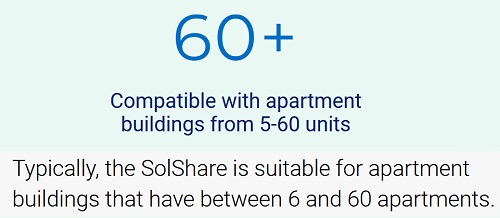
Get it right!
It is possible to have fewer than five connections but reducing the number of users will also reduce the increase in solar self-consumption. This means it may not be economically worthwhile to have under five or six connections.
Solar System & Inverter
Technically, the maximum solar inverter capacity you can connect to a SolShare is 22 kilowatts. Solar panel capacity can be up to one-third larger, making 29.33 kilowatts the largest possible system size. In practice, the largest inverter used is likely to be 20 kilowatts. This will allow up to 26.66 kilowatts of solar panel capacity per SolShare.
SolShare will work with any inverter or combination of inverters provided their total capacity is 22 kilowatts or less, and their output is across 3-phases. So you can use a three-phase inverter, 3 single-phase inverters or even microinverters spread across the phases.
Retrofits Are Fine
SolShare can be used with new solar installations or retrofitted to existing solar systems. So long as they meet its requirements, SolShare can make use of inverters that are already in place.
Multiple SolShares Mean Multiple Solar Systems
Multiple SolShares can be used, but each will be part of a separate solar system with its own inverter and panels.
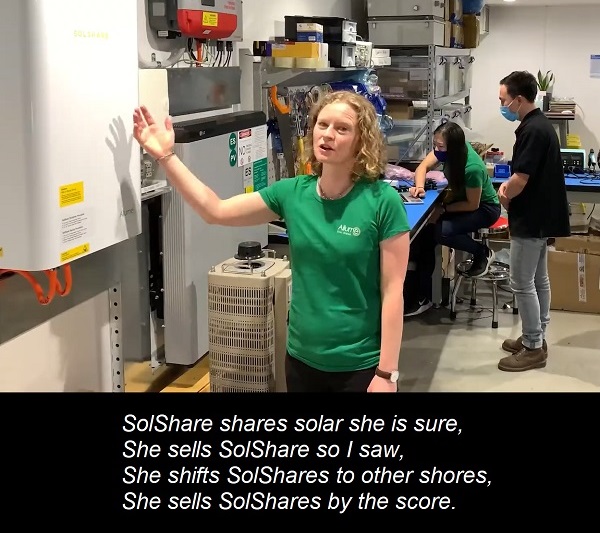
Per Unit Solar Capacity Can Be Low
If 15 units are connected to a SolShare with a 20 kilowatt inverter and 26 kilowatts of panels, then each flat’s solar panel capacity will only be 1.73 kilowatts. So even with a solar system as large as possible, solar panel capacity per user is small. But this may not be a problem because…
-
-
- Many Strata properties only have a limited amount of roof space for solar panels, so a small amount per user may be all that can be installed.
- SolShare boosts self-consumption, so users will consume more solar energy than normal from their portion of capacity.
- Multiple SolShares can be used to allow for greater capacity per user. If the 15 units in the example above instead used two SolShares, then they would have around 3.5 kilowatts of solar capacity each. Eight would have a little less and seven would have a little more.
-
Not Everyone Has To Join
If there is a ten-unit block and eight owners want solar power, and two aren’t interested but not opposed, then all ten flats would be connected to the SolShare, but solar would only be supplied to the eight participants. Connecting all the flats allows holdouts to join if they change their minds. It also lets new residents join if the holdouts move out.
Say there is a block of 20 flats and 10 want solar, one solar system plus SolShare can be installed and connected to those flats. Later, once people see the reductions in electricity bills it provides, a second solar system with SolShare can be installed and connected to the remaining 10 flats.
Batteries Can Be Used
So long as a suitable inverter is used, SolShare can allow a single battery to be shared between multiple users. This is handy because installing one large battery can be much cheaper than multiple small ones. Because it’s shared, it can also be used at a higher capacity factor.
It’s also much better for the residents than a trendy ‘community battery’ because it is behind the meter, reducing bills by the full retail tariff.
Also, while a shared battery can provide backup power during a blackout, it’s not likely to be practical. You’d need a hybrid solar inverter with full 3-phase backup and arrangements to prevent users from pulling too much power and overloading the battery, or too much energy and draining the battery.
No Restrictions On Electricity Plans Or Retailers
SolShare doesn’t affect which electricity plans or retailers individual residents can use, but it’s still worth shopping around for the best electricity plan after the installation. Just bear in mind that because your solar exports are likely low thanks to high self-consumption, plans with high feed-in tariffs may not be the most cost-effective.
How SolShare Shares Solar
SolShare tries to distribute solar generation to users evenly. If it notices one user is getting ahead, it will prioritize others. Similarly, if one is falling behind, it will make it a priority. But it can be configured to send more/less energy to some. For example, single-bedroom flats in a block could be given a smaller share than two-bedroom flats.
Tech Specs
Here are some technical specs for the SolShare. If you want to see its full datasheet, there’s a link on this page.
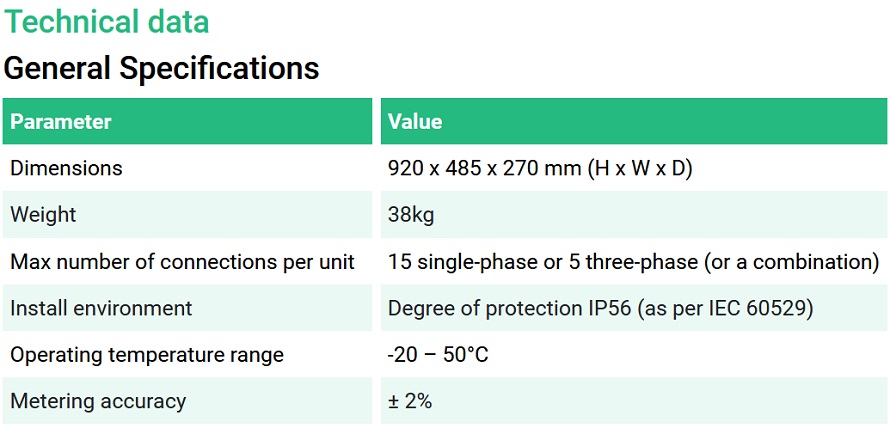
Size & Weight: It’s roughly a metre high and half a metre wide. At 38 kg, it’s not light but can be wall-mounted.
Installation Location: Its Ingress Protection rating is IP56. This means it’s resistant to dust and can withstand being hosed down. This doesn’t mean you should hose it down, but if it does get sprayed, it should be fine. It can be installed outside but should be in a shaded location.
Operating Temperature: The operating temperature range is -20 to 50 degrees. This is a good range for Australia because only very remote areas have cracked 50 degrees… so far.
Metering Accuracy: At plus or minus 2% it’s not perfect, but good enough.
Warranty
SolShare has a warranty of 10 years. I’d like to congratulate Allume Energy for giving it a warranty period I consider reasonable. A two-year warranty is common for non-inverter solar hardware in Australia.
How Can I Get SolShare?
Provided you can get enough residents to agree, you can purchase a system together. If you contact Allume Energy they’ll let you know if it can go ahead. For 15 users sharing the cost, they give a price range of $2,500 to $3,000 each ($37,500 to $45,000 total) for a SolShare enabled solar system of up to around 1.7 kW each. This is the total cost of the system including solar panels, inverter, SolShare, and installation.
I also suggest looking at the alternative approaches listed earlier to compare the costs and savings.
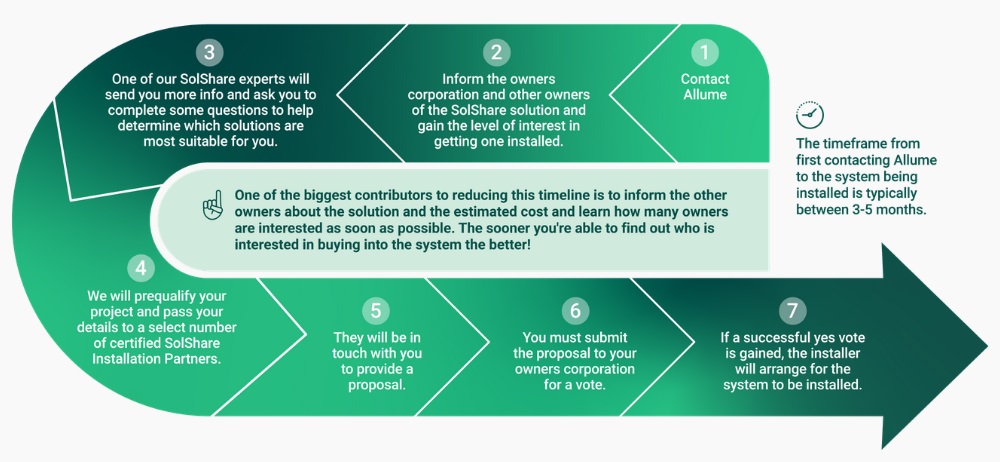
This graphic from Allume Energy shows the rather involved process of getting a SolShare solar system.
If you are a renter, you can let your landlords know about SolShare and hope they’ll be interested. While landlords have a reputation for rarely wanting to improve their properties, you never know your luck.
No Money Down
It’s also possible to get a solar system with SolShare installed for no money upfront through a power purchase agreement plan. You will still pay for the system, but through your electricity bills. This approach may persuade reluctant Strata members to agree to get solar panels. With these agreements, I strongly recommend carefully checking the terms and conditions and considering if you and your neighbours would be better off buying the system outright.
3-5 Months To Installation
Getting a SolShare system installed on a Strata property can be a long and involved process. Allume Energy says it takes 3-5 months from the start of the process to a completed installation.
Financial Assistance For SolShare
Some local councils offer financial assistance to help pay for a system such as SolShare:
Adelaide City Council: As part of their sustainability incentives, Adelaide City Council will provide a rebate of $500 per premise for shared solar. For a 10-premise SolShare installation, this would come to $5,000 or roughly 12% of the total. The maximum possible amount of rebate would be $7,500 for 15 premises. This only applies in the Adelaide CBD and not the whole of Adelaide.
Randwick City Council: This local council in East Sydney offers a rebate that should come to 25% of the cost per user.
ACT: Pensioners may be able to receive financial assistance in the ACT as part of their Home Energy Support program.
I’ve also heard Moonee Valley Council in Victoria may soon offer financial assistance.
Australian Technology For The Win
Roughly one in ten Australians live in multi-occupancy buildings and face serious barriers to enjoying the benefits of solar power. But now… well, it’s still hard now. Getting Strata members to agree on anything, no matter how sensible, is like trying to herd turtles in dingo country. Even the well-meaning can be awfully slow and, no matter how carefully you go about it, there’s still a chance you’ll end up getting your arse chewed.
It has slowly been getting easier to install solar on Strata, and Allume Energy’s SolShare should move things a long way in the right direction. It’s not perfect. For one thing, it doesn’t magically cost zero dollars. But it does have the potential to unlock solar ownership and/or use for over two million Australians.
As an Australian-made product, it’s another example of how Australia is leading the world in rooftop solar power. It’s not only being used here but also in the UK and the US. But its appeal isn’t limited to only English-speaking and English-mangling countries. There’s also plenty of interest in Europe, where 40% of the population lives in apartments. Currently, Allume Energy has overseas offices in California and Paris, so here’s hoping we see lots of SolShares around the world.
Original Source: https://www.solarquotes.com.au/blog/allume-energy-solshare-review/

